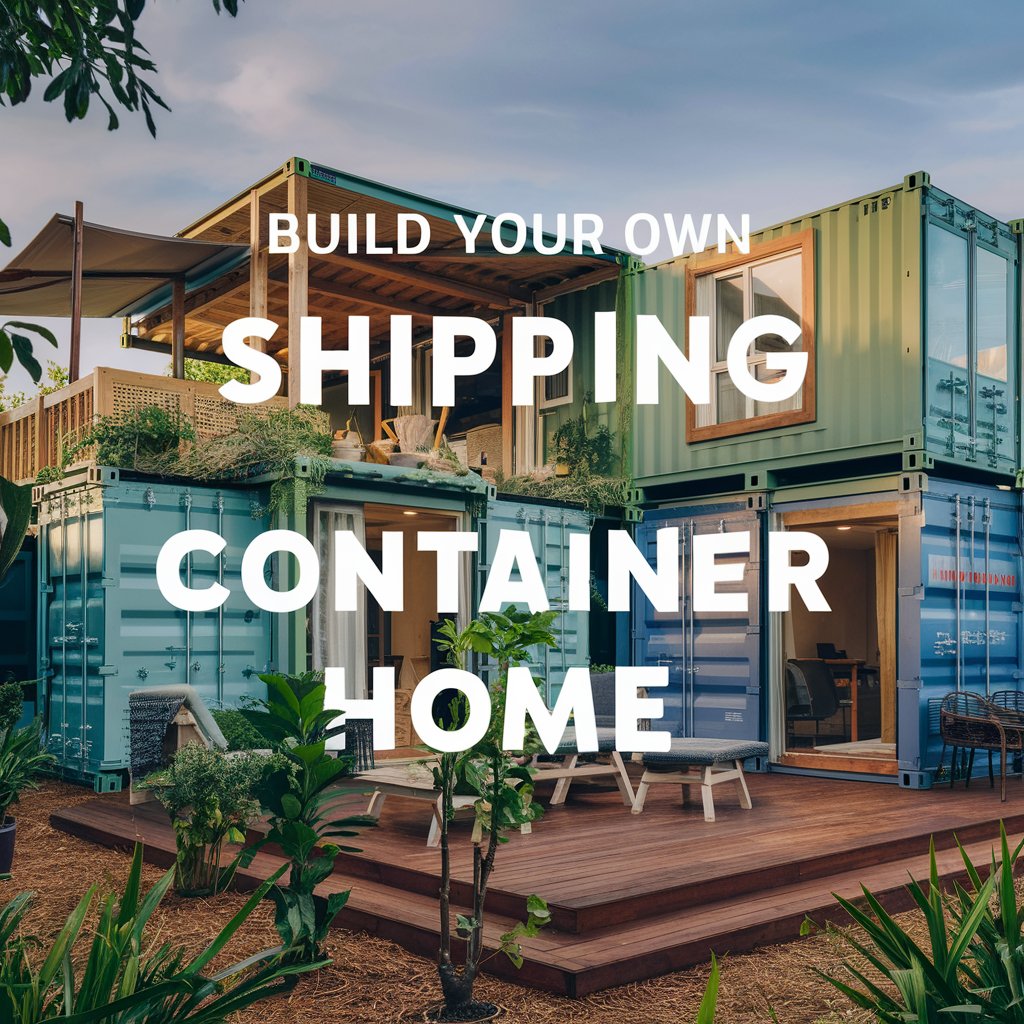Planning Your Shipping Container Home
Building your own shipping container home is an exciting way to create a unique, cost-effective living space, but proper planning is key to making your project successful. One of the first steps is determining the layout and size of your home based on the number of containers you’ll need, as well as your budget, location, and local building codes.
Using a comprehensive guide, like Build Your Own Shipping Container Home – Step by Step Comprehensive Guide, will save you a lot of time and headaches. This package includes four books full of expert advice, superb container home plans, examples of container architecture, and even a home interior design planner to help you visualize and map out your dream container home.
Once you’ve decided on the layout, consider how you’ll configure the containers. Some people stack containers for multi-story homes, while others use side-by-side layouts for larger open living spaces. This flexibility allows for creative, customized designs.
Proper planning also includes determining your budget and accounting for additional costs, such as insulation, electricity, plumbing, and foundations. Be sure to research local building permits and zoning laws, as some areas have specific regulations for container homes.
For more tips on how to organize your space once construction is complete, check out this sliding frame for tote organization guide to keep your new home clutter-free.

Choosing and Preparing Your Shipping Containers
Once you’ve planned the layout for your shipping container home, the next step is sourcing your containers. Shipping containers come in various sizes, with the most common being 20 feet and 40 feet long. You can often find used containers at lower prices, but make sure they are in good condition and free of structural damage. Look for containers that are “cargo-worthy” or “wind and watertight”, which ensures they are durable enough for long-term use.
Preparing the containers is one of the most important steps in the process. Start by inspecting them for rust, dents, or hazardous materials. If needed, repair any damage and clean the containers thoroughly. The containers will also need to be modified with door and window cutouts, so having a clear design plan is crucial at this stage.
For cutting through the metal, tools like grinders or plasma cutters are commonly used. You’ll also need to ensure that the containers are properly insulated, as metal conducts both heat and cold. There are several insulation options, from spray foam to paneling, which you can explore in more detail with resources like Build Your Own Shipping Container Home.
Once your containers are cleaned, repaired, and ready, you can begin planning the foundation and framing. For an outdoor touch, you might also consider adding features like angled board hangers for lawn chair storage to make your outdoor areas more functional.
Laying the Foundation and Framing
Once your containers are ready, it’s time to prepare a solid foundation. Unlike traditional homes, shipping container homes require a foundation that can handle the weight and keep the containers level. Some of the most popular foundation options include concrete piers, a concrete slab, or a crawl space. The type of foundation you choose will depend on your location, soil conditions, and personal preference.
- Concrete Piers: These are cost-effective and ideal for uneven terrain. You’ll dig holes and fill them with concrete, placing the piers where the corners and edges of the container will rest.
- Concrete Slab: For a sturdier and more permanent foundation, a concrete slab provides a flat, solid base, making it easier to install utilities like plumbing and electricity.
- Crawl Space: If you need additional space for utilities, a crawl space foundation allows you to run wiring and plumbing beneath the home easily.
Once the foundation is complete, you’ll begin framing the interior. This involves building interior walls, cutting out spaces for doors and windows, and reinforcing areas where you’ll install cabinetry or appliances. The steel structure of the container adds a unique challenge, so it’s important to use metal fasteners and framing techniques that can withstand the material’s strength.
For extra interior organization after construction, consider building functional pieces like a DIY farm-style end table or tote organization system to optimize space in your new home.

Installing Insulation and Utilities
One of the key steps in making a shipping container home livable is properly insulating it. Since containers are made of metal, they can become extremely hot or cold depending on the weather. Proper insulation will regulate the temperature inside and prevent condensation, which can lead to rust or mold.
- Choosing Insulation:
- Spray Foam Insulation: This is one of the best options for shipping containers. It forms a tight seal against the metal, preventing moisture and offering excellent thermal insulation.
- Fiberglass Batts: A more affordable option, fiberglass batts can be installed between metal studs, but they don’t offer as much protection against moisture.
- Rigid Foam Panels: These are easy to install and provide a good balance between cost and performance, though they might not insulate as well as spray foam.
- Installing Utilities:
- Plumbing: You’ll need to plan your plumbing layout carefully, especially if using a concrete slab or crawl space. Consider eco-friendly options like composting toilets or greywater systems.
- Electrical Wiring: Electrical work in a shipping container home requires precision. You’ll need to drill holes for wiring and install outlets within the metal framework. Solar panels are also a great option for off-grid living.
- Ventilation: Proper airflow is essential to prevent condensation and ensure a comfortable living space. Install windows, vents, or even skylights to improve airflow.

For more detailed guidance on customizing your shipping container, Superb Container Home Plans & Projects can offer step-by-step plans that help with design, insulation, and utility installation. Once your utilities are in place, it’s time to move on to the final finishing touches.

Get the best in detail guide on building your own container home here!
Adding Finishing Touches and Customization
With insulation and utilities installed, the final step is customizing and finishing your shipping container home to make it truly yours. This is where your design choices come to life, transforming the industrial structure into a cozy, livable space.
- Interior Finishing:
- For walls, consider using drywall or wood paneling to create a more traditional home feel. You can also leave some areas of the container’s steel walls exposed for a modern, industrial look.
- Flooring options include polished concrete, wood, or vinyl, depending on your budget and desired aesthetic.
- Add your personal style with fixtures, paint colors, and furniture that reflect your taste.
- Exterior Customization:
- Painting the exterior of your shipping container is essential to protect it from the elements and rust. Choose a durable exterior paint, and consider adding features like awnings or decks to expand your outdoor living space.
- Landscaping around your container home can also enhance its look and help blend it into the surrounding environment. Simple outdoor storage solutions, such as angled board hangers for lawn chairs, can keep your outdoor area tidy.
- Maximizing Space:
- Since space inside a shipping container home is limited, making smart use of every square foot is crucial. Consider built-in shelving, under-bed storage, or multi-purpose furniture like a DIY multipurpose wooden table to maximize functionality.
- Interior Design:
- Once construction is done, it’s time to furnish and decorate your new space. Use the Home Interior Design Planner Application, included in the container home package, to help layout furniture, colors, and decor to match your vision for your shipping container home.
With your shipping container home complete, you’ll have a unique, sustainable living space that reflects your personality and style. Whether it’s your primary residence, vacation retreat, or even the start of a container home business, this project offers endless possibilities.
Why Build a Shipping Container Home?
The popularity of shipping container homes has skyrocketed in recent years, and for good reason. Building a home from shipping containers offers a unique, eco-friendly, and budget-friendly alternative to traditional construction. Here are a few compelling reasons why many homeowners are turning to containers as their housing solution:
- Cost-Effective:
- Compared to traditional home construction, using shipping containers can significantly reduce costs. Containers themselves are often available at lower prices, especially if you source used ones. With proper planning and smart budgeting, you can build a sturdy, modern home for a fraction of the cost of conventional housing.
- You can find detailed pricing strategies and examples in My First Container Home, which helps first-time builders understand how to save on material and labor.
- Sustainability:
- Shipping container homes are a great way to recycle and repurpose used materials. Instead of leaving old containers to rust in shipyards, you can give them a second life as a functional, stylish home. This makes it a sustainable building option that minimizes your environmental footprint.
- Pair your container home with eco-friendly additions, like solar panels and rainwater collection systems, for a truly green living space.
- Durability and Strength:
- Shipping containers are designed to withstand extreme weather conditions and rough handling during transport, making them highly durable. When properly modified and insulated, they offer excellent structural integrity and are resistant to pests, rot, and fire.
- With a proper foundation and reinforced framing, you can build a multi-container structure that rivals traditional homes in both strength and longevity.
- Customizable and Unique Design:
- Shipping containers offer endless customization possibilities. You can stack them, cut out sections for open spaces, or combine multiple containers to create larger rooms. Your design is only limited by your imagination, whether you want a modern, minimalist look or a rustic, cozy retreat.
- To see some inspiring design examples, check out Superb Examples of Container Architecture, which showcases creative ways architects have transformed containers into stunning homes.
Building a shipping container home not only allows you to save money but also gives you the opportunity to create a unique, eco-friendly space tailored to your needs. With the right resources and careful planning, your dream container home can become a reality.

Shipping Container Home Challenges and Solutions
While building a shipping container home offers numerous benefits, there are also unique challenges that come with working with these steel structures. However, with proper planning and knowledge, most of these challenges can be overcome, leading to a smooth build and a durable, comfortable home.
- Insulation and Temperature Control:
- Challenge: Shipping containers are made of steel, which means they heat up quickly in hot climates and become extremely cold in colder environments. Without proper insulation, your container home may struggle to maintain comfortable temperatures.
- Solution: Opt for high-quality insulation like spray foam or rigid foam panels, which not only provide good temperature control but also help prevent moisture buildup. Ventilation is also key—install windows, vents, or skylights to ensure adequate airflow throughout the home.
- Moisture and Condensation:
- Challenge: Since metal easily attracts condensation, moisture can build up inside the container, leading to rust, mold, or mildew if not addressed properly.
- Solution: Using a vapor barrier during the insulation process will help prevent condensation from forming on the inside of the container walls. Proper sealing, along with ventilation systems, will help minimize moisture buildup.
- Structural Modifications:
- Challenge: Cutting large openings in shipping containers for doors, windows, or open floor plans can weaken the structure, leading to instability or sagging if not properly reinforced.
- Solution: Always reinforce any areas where metal is removed by adding steel or metal framing. Hiring a professional welder or contractor for structural modifications may be necessary to ensure the stability of your container home.
- Permits and Zoning Regulations:
- Challenge: Not all municipalities allow the construction of shipping container homes, and some may have strict building codes or zoning regulations that apply to non-traditional housing.
- Solution: Before beginning your project, research local building codes and zoning laws. Obtain the necessary permits and ensure your home design meets local regulations. Consulting with a contractor familiar with container homes can help navigate the legal side of the project.
- Electrical and Plumbing Installation:
- Challenge: Running electrical wiring and plumbing through a steel structure can be tricky due to the nature of the material.
- Solution: Plan your electrical and plumbing layout early in the design process. You can drill holes through the steel to install wiring and piping but be sure to use proper seals to avoid leaks and damage. You might also consider raising the container on a platform or crawl space to give easier access for utilities.
By addressing these challenges head-on, you can ensure that your shipping container home build goes smoothly. For a comprehensive guide on overcoming construction challenges, as well as real-world examples and detailed plans, check out Superb Container Home Plans & Projects.
As an Amazon Associate we earn from qualifying purchases through some links in our articles.



